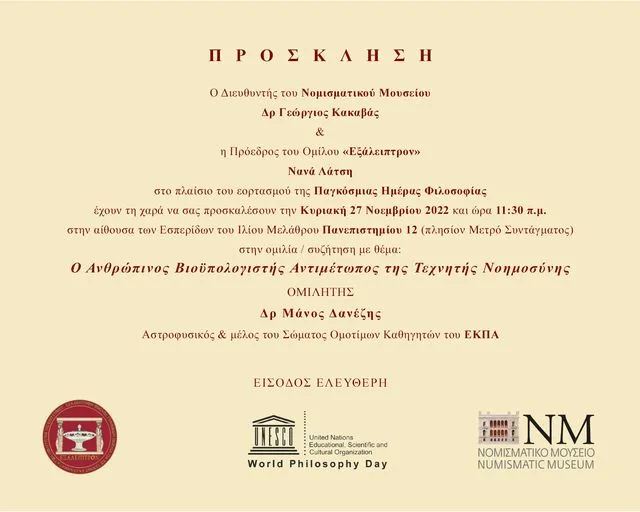The word Mystery means secrecy, secret and comes etymologically from the verb “myin” which means close. The Mystic-mystagog, practicing the secret worship towards the divine, looks forward to the union, to the cohesion of the community of initiated, superior spiritual people. The eon truths of the human soul, as natural and allegorical representations of people, through Demeter, the earthly deity and Hades-death, are revealed to the initiates. The Earth as a mother with a rural character and fertility condenses life and death, the alternation of light and shadow as a natural and metaphysical phenomenon.
The origin of the Eleusian Mysteries is pre-Greek, Pelasgical or Mycenaean. For the first time the commission of mysteries is located in Boeotia. The Achaeans and Ionians adopted and dedicated yesterday’s deities, while the Eumolpides, the royal genus of Eleusis, were among the first Hierofantes, Preachers and Dames of the Eleusin Mysteries.
The Athenians were, of course, the ones who “take off” the Eleusinian Mysteries, resulting in their ultimate heyday. Since the time of the afternoon of the 5th century. A.D. and the glamour of the tyranny of the Pisistratids, political, economic and social reasons led Athens to an unprecedented spiritual hegemony. Pericles’ Resolution on the abolition of annuities in the Eleusinian Mysteries eliminated their elitist character, since in previous years they were intended only for high “entrances”. However, the “opening” of the Mysteries to all but the non-speaking Greek (e.g. Persians) makes them of lower intellectual quality.
The Great Mysteries lasted 9 days and were considered a Panhellenic Feast. Every Fall, at the beginning of October, from the time of the Tyrannida of the Pisistratids at the height of the 5th century. B.C. the Athenians performed the Eleusinian Mysteries by transferring the sacred objects to a kisti (basket) from Eleusis to Athens and vice versa. The Lord King in the Variety Of the Adus was at the fore in the purification with salt water and later on the way to the Holy Road to Eleusis. In Kifissos’s attitude, obscenities and obscene jokes were the harbinger of the mysterious ritual of the Ceremony: the alternation of darkness and light consistent with the architectural construction of the building, the events for Mother, Daughter and Pluto (as depicted mainly in ancient works of art) that symbolize the sacred marriage of life and death, propelled Aristophanes, Plato , other ancient and Christian writers as well as younger scholars, such as Fukar and Noak, assume the use of machines to impress during the commission of the Eleusin Mysteries.
These strong theatrical elements as well as the strong symbolisms (stack of the impossible, initiation, Ceremony, Supervision) will later offer Christianity, according to the testimony of Hippolytus, a Christian writer of the 2nd century BC. Ad. , ideological content compatible with that of Eleusis: harvest=death/hope=expectation of resurrection. Of course, with the advent and final predominance of Christianity and its Eschatological Teaching, the Eleusinian Mysteries took on a more ritualistic and astory character.
The word Mystery means secrecy, secret and comes etymologically from the verb “myin” which means close. The Mystic-mystagog, practicing the secret worship towards the divine, looks forward to the union, to the cohesion of the community of initiated, superior spiritual people. The eon truths of the human soul, as natural and allegorical representations of people, through Demeter, the earthly deity and Hades-death, are revealed to the initiates. The Earth as a mother with a rural character and fertility condenses life and death, the alternation of light and shadow as a natural and metaphysical phenomenon.
The origin of the Eleusian Mysteries is pre-Greek, Pelasgical or Mycenaean. For the first time the commission of mysteries is located in Boeotia. The Achaeans and Ionians adopted and dedicated yesterday’s deities, while the Eumolpides, the royal genus of Eleusis, were among the first Hierofantes, Preachers and Dames of the Eleusin Mysteries.
The Athenians were, of course, the ones who “take off” the Eleusinian Mysteries, resulting in their ultimate heyday. Since the time of the afternoon of the 5th century. A.D. and the glamour of the tyranny of the Pisistratids, political, economic and social reasons led Athens to an unprecedented spiritual hegemony.Pericles’ Resolution on the abolition of annuities in the Eleusinian Mysteries eliminated their elitist character, since in previous years they were intended only for high “entrances”. However, the “opening” of the Mysteries to all but the non-speaking Greek (e.g. Persians) makes them of lower intellectual quality.
The Great Mysteries lasted 9 days and were considered a Panhellenic Feast.Every Fall, at the beginning of October, from the time of the Tyrannida of the Pisistratids at the height of the 5th century. B.C. the Athenians performed the Eleusinian Mysteries by transferring the sacred objects to a kisti (basket) from Eleusis to Athens and vice versa. The Lord King in the Variety Of the Adus was at the fore in the purification with salt water and later on the way to the Holy Road to Eleusis. In Kifissos’s attitude, obscenities and obscene jokes were the harbinger of the mysterious ritual of the Ceremony: the alternation of darkness and light consistent with the architectural construction of the building, the events for Mother, Daughter and Pluto (as depicted mainly in ancient works of art) that symbolize the sacred marriage of life and death, propelled Aristophanes, Plato , other ancient and Christian writers as well as younger scholars, such as Fukar and Noak, assume the use of machines to impress during the commission of the Eleusin Mysteries.
These strong theatrical elements as well as the strong symbolisms (stack of the impossible, initiation, Ceremony, Supervision) will later offer Christianity, according to the testimony of Hippolytus, a Christian writer of the 2nd century BC. Ad. , ideological content compatible with that of Eleusis: harvest=death/hope=expectation of resurrection. Of course, with the advent and final predominance of Christianity and its Eschatological Teaching, the Eleusinian Mysteries took on a more ritualistic and astory character.
Amalia K. Iliadis – Source: http://www.e-telescope.gr/el/mystery-and-strange/555-mysteries-of-elsfsis















